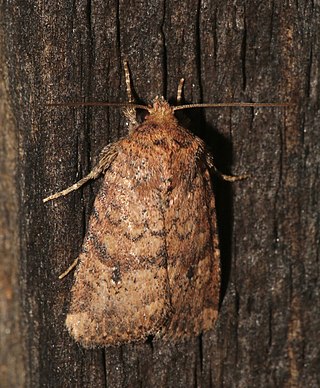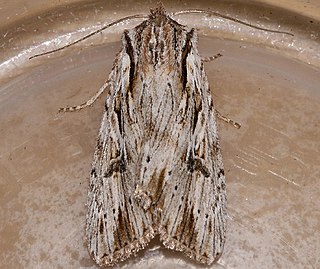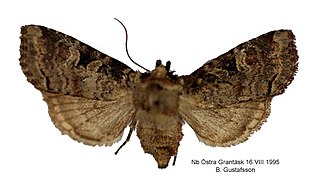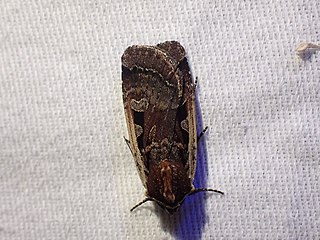
Homorthodes furfurata, the northern scurfy Quaker moth or scurfy Quaker moth, is a species of moth in the family Noctuidae . It was described by Augustus Radcliffe Grote in 1874 and is found in forest habitats in North America. Its range extends across the continent, to south-eastern Canada, Massachusetts, New York, and Mississippi. In the west it ranges south to California, Arizona, New Mexico and Texas.
Parabagrotis cupidissima is a species of moth in the family Noctuidae. It was described by Augustus Radcliffe Grote in 1875 and is found in North America, where it ranges from southern Vancouver Island, along the Pacific Coast states, to southern California. The habitat consists of grasslands and oak woodlands.
Annaphila arvalis is a species of moth in the family Noctuidae. It was described by Henry Edwards in 1875 and is found in North America, where it has been recorded from foothill canyons and riparian habitats in south-eastern British Columbia, eastern Washington, north-central Oregon, south to southern California.
Lacinipolia incurva is a species of moth in the family Noctuidae. It was described by John B. Smith in 1888 and is found in North America, where it has been recorded from California, Arizona, New Mexico, Texas, Utah and Colorado.
Euxoa occidentalis is a species of cutworm or dart moth in the family Noctuidae. It was described by J. Donald Lafontaine and J.R. Byers in 1982 and is found in North America.
Xestia verniloides is a species of cutworm or dart moth in the family Noctuidae. It was described by J. Donald Lafontaine in 1998 and is found in North America.

Papaipema speciosissima, the osmunda borer or regal fern borer, is a species of cutworm or dart moth in the family Noctuidae. It was described by Augustus Radcliffe Grote and Coleman Townsend Robinson in 1868 and is found in North America.

Xestia infimatis is a species of cutworm or dart moth in the family Noctuidae. It was described by Augustus Radcliffe Grote in 1880 and is found in North America.
Euamiana endopolia is a moth in the family Noctuidae. It was described by Harrison Gray Dyar Jr. in 1912 and is found in North America.
Xestia laxa is a species of cutworm or dart moth in the family Noctuidae. It was described by J. Donald Lafontaine and Kauri Mikkola in 1998 and is found in North America.

Hillia iris, the iris rover, is a species of cutworm or dart moth in the family Noctuidae. It was described by Johan Wilhelm Zetterstedt in 1839 and is found in North America.
Perigonica pectinata is a species of cutworm or dart moth in the family Noctuidae. It was described by Smith in 1943 and is found in North America.
Chaetaglaea fergusoni, or Ferguson's sallow moth, is a moth in the family Noctuidae. It was described by Vernon Antoine Brou Jr. in 1997 and is found in North America.
Lineostriastiria hachita is a moth in the family Noctuidae. It was described by William Barnes in 1904 and is found in North America.
Cobubatha megaplaga is a moth in the family Noctuidae. It was described by Harrison Gray Dyar Jr. in 1912 and is found in Central and North America.
Homorthodes dubia is a species of cutworm or dart moth in the family Noctuidae. It was described by William Barnes and James Halliday McDunnough in 1912 and is found in North America.
Dichagyris neoclivis is a species of cutworm or dart moth in the family Noctuidae. It was described by William Barnes and Foster Hendrickson Benjamin in 1924 and is found in North America.

Tesagrotis corrodera is a species of cutworm or dart moth in the family Noctuidae. It was described by Smith in 1907 and is found in North America.
Parabagrotis formalis is a species of cutworm or dart moth in the family Noctuidae. It is found in North America.

Parabagrotis exsertistigma is a species of cutworm or dart moth in the family Noctuidae.





